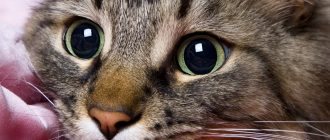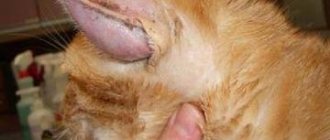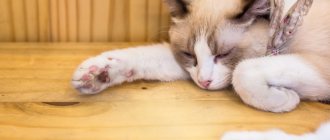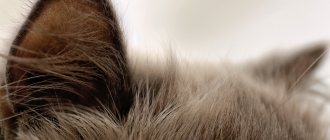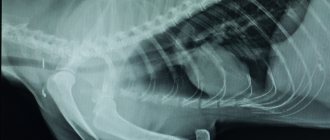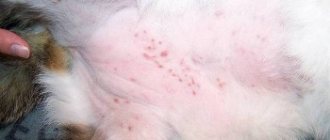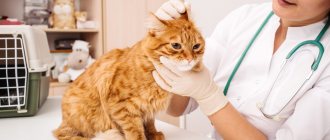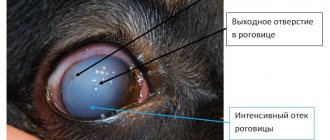7550Administration
The appearance of sores on a cat’s neck brings a lot of worry and trouble to the owner. And it’s not sweet for the animal itself. Often the sores are accompanied by itching and pain. The cat scratches them, which further aggravates the situation. If you notice a sore in the form of a rash, sores, pimples, etc., you must definitely find out the cause and treat your pet.
Some pathologies can cause serious damage to the health of your home. This article will help you understand what causes neck sores in cats and how to deal with them. The most common situations are discussed below.
© shutterstock
Causes
Skin lesions of the neck occur for the following reasons:
If the cat is itching, but there are no fleas or they have recently been expelled, the cause of the disease should be looked deeper. Skin scrapings may reveal hypodermal mites. Most often, Demodex and Notoedrus are found in cats.
Before applying medications to the affected area of the neck, the hair is cut to open access for the action of the medications and to monitor the cat’s condition over time. Treatment of the disease is carried out using the following groups of medications:
- Symptomatic.
- General strengthening
- System
Symptomatic remedies are put in front because if the diagnosis is unclear, one cannot waste time allowing the development of the pathological process. These are external, cleansing skin from scabs and anti-inflammatory agents in the form of ointments, gels or aerosols. Complex systemic preparations that have acaricidal, antimicrobial, antimycotic, and anti-inflammatory effects are moistened onto the prepared surface.
At the same time, medications are used that increase immune defense
Allergic reaction
The second most common cause of hypersensitive reactions after flea dermatitis is food allergy. If this type of pathology is suspected, diagnostic procedures are combined with therapeutic ones. Finding out which component causes dermatitis is a difficult task. Therefore, the animal is given hypoallergenic food, while simultaneously undergoing desensitization therapy with medications containing Dexamethasone. When improvement occurs, restorative drugs and immunomodulators are prescribed. It may take months for you to fully recover.
Another type of allergy, atopic dermatitis, develops against the background of an innate predisposition to violent reactions to irritants. Such a cat is excluded from breeding.
The disease is incurable, but methods that can minimize complications have been developed. In addition to symptomatic treatment, the cat is isolated from the irritant. If there is a suspicion of hypersensitivity, the substances with which the flea collar is impregnated are snatched, it is removed. During the flowering of allergenic plants, the cat is not allowed to walk, and the apartment windows are left closed. It is possible that you will have to change the litter in the cat's litter box.
Lichen
Among fungal infections, Microsporia is the most common. The spores are resistant to medications and can cause secondary infection.
Antimycotic drugs are divided into the following drug groups:
- External. Solutions, gels, and ointments are used. To facilitate access to the active substances, six are cut off. Licking is prevented by using an Elizabethan collar.
- Oral. Tablets have severe side effects, so they are used when external medications are ineffective.
- Parenteral. Immunomodulators are used, as well as anti-inflammatory drugs for severe cases of the process.
For weeping eczema, drying agents are used, and dry eczema is treated with moisturizing external medications. The acute course requires the use of analgesics, as well as steroidal antiphlogistics. The composition of ointments includes antimicrobial agents. The use of immunomodulators speeds up the healing process.
Owners often ignore the appearance of black spots on their pet’s chin: “Just think, acne in cats is quite common and is not dangerous.” However, if you dig deeper, it turns out that blackheads and pimples on a cat's chin can be a sign of a number of diseases or the result of improper care. Why do acne appear on the skin of some pets and how to treat acne in cats?
In advanced cases, acne and pimples in cats are visible not only on the chin, but also on the inner thighs, on the elbows, around the genitals and anus, between the fingers. If these are not individual points, but scatterings of crusts and ripening ones, be sure to contact your veterinarian.
Blackheads are oxidized plugs that clog skin pores. Most of the plug is made up of sebum produced by the sebaceous glands. When the sebaceous gland begins to overproduce sebum, acne appears in cats (just like in humans).
Why do acne appear on a cat's chin and not in other parts of the body? The fact is that the more hairs per centimeter of skin, the fewer sebaceous glands in this area and the less developed they are. And on the chin the hair is usually sparse and short. In addition, the chin constantly becomes dirty while eating, and the cat cannot wash it thoroughly, which contributes to disruption of the functions of the sebaceous glands. Therefore, acne in cats rarely appears on other parts of the body - the cat is carefully licked, removing the accumulated layer of contaminated sebum.
However, pollution is not the only cause of acne. For example, if a cat develops acne on its body even with proper care, heredity may be to blame - the sebaceous glands work excessively from birth, which is an individual feature and cannot be treated, but is controlled by hygiene products. In addition, acne on a cat’s chin can appear as a result of improper feeding, hormonal imbalance, liver or gastrointestinal disease, disorders of the central nervous system, autonomic and immune disorders.
Black spots and pimples on cats' ears are a consequence of insufficient care. Normally, earwax is produced in limited quantities and does not interfere with the normal functioning of the sebaceous glands. But the ears of some pets need regular cleaning due to the rapid accumulation of wax - this is also an individual feature inherent in individual individuals or breeds (for example, hairless and curly-haired cats, pets with large “open” ears). Sometimes acne in cats' ears appears due to excessive grooming, when owners maniacally clean the surface of the ears - the glands, trying to make up for the “losses” and restore the protective layer, begin to work with a vengeance.
Recently, skin diseases have become widespread in cats, from which, according to statistics, every third pet suffers. Often, problems with the skin are the result of some internal pathology that requires immediate treatment. Many skin diseases pose a danger not only to the cat, but also to the owner, so it is extremely important to promptly recognize the disorder and begin treatment.
A cat has a bump on its head: Possible causes
If you find a lump on your pet's head, the reasons may be the following:
- Lipoma formation.
- Abscess formation.
- Metastases of a malignant tumor of any organ.
Lipomas are formed from cells of subcutaneous fatty tissue and are benign formations; with trauma they can degenerate into malignant ones. The reliable reason for their formation, however, like all neoplasms, is unknown.
Abscesses can form at the site of an injury, a bite during a fight with other animals when the immune system is weakened and the wound is contaminated, when the animal has access to the street, or its habitat in the apartment is polluted. The cat's scratching and licking of the wound plays an important role.
Since the formation can be a signal of a serious pathology, it is necessary to immediately contact a veterinary clinic.
After the diagnosis, which will necessarily include a tissue biopsy or puncture followed by histological examination, the veterinarian will select the necessary treatment tactics.
Watch the video: Ear mites - How to cure a cat at home
When you see a cat scratching its neck, the first thought that arises is that the animal is infected with fleas, since most often they are the cause of the itching. However, this condition can be caused by many factors. Each of them requires careful study in order to provide the correct treatment.
List of skin diseases in cats
There is a whole spectrum of skin diseases that are diverse in nature and manifest themselves in completely different ways. Skin lesions can be caused by a variety of reasons - hereditary, anthropogenic, infectious; even a simple change in diet can cause rashes on the body.
Attention. We should not forget that fleas are carriers of helminths and can infect an animal through a regular bite. Therefore, along with treatment for fleas, the animal should be dewormed in a timely manner.
Itching caused by helminths
There are a large number of varieties of parasitic worms that take up residence in a cat’s body. They can be:
Usually at the very beginning of infection it is difficult to consider any of its symptoms, but after a while the animal:
- loses appetite and activity;
- becomes restless;
- Constantly licks and itches.
Worms found in the intestines are considered almost harmless.
The movement of worms throughout the animal’s body is accompanied by the following symptoms:
- sudden weight loss, increased fatigue, growth retardation in small pets;
- disheveled wool;
- enlarged liver and icteric staining of visible mucous membranes;
- disruption of the digestive system, expressed in constipation, vomiting, diarrhea;
- appearance of cough;
- discharge from the eyes;
- itching in the anus;
- presence of blood in feces;
- premature birth or miscarriage in cats;
- convulsions and paresis of the limbs.
The cat may not notice the presence of parasites in the body in small quantities. However, their increase will not only exhaust the animal, but will also lead to its death. The harm caused to pets by worms can be completely different :
- eating lymph, tissue and blood;
- release of substances that promote intoxication;
- damage to the mucous membranes by suction cups, leading to internal bleeding.
After the worms die, decomposition products are formed that poison the animal’s body. The appearance of parasites leads to metabolic disorders, as a result of which the cat’s skin becomes dry and dandruff appears on it. Just like an allergic reaction, these factors are accompanied by itching, which causes the animal to scratch its neck until it bleeds.
A pet can become infected with helminths in the following ways::
- eating raw meat or fish (especially river fish);
- flea bites;
- contacts with other animals.
Ringworm
Ringworm is an infectious fungal pathology that often affects young animals with reduced immunity, as well as cats that have suffered from cancer or viral diseases.
The cause of the disease is fungal spores, which can be carried on clothes or shoes. Infection occurs through contact with a sick animal, through shared toys, feeding and care items.
Clinical signs of ringworm are:
- bald areas on the head, tail and limbs;
- in the center of the affected area, the skin turns red and peels, sometimes ulcers, white scales and crusts appear.
Treatment of the disease is carried out using antifungal ointments and antiseptic solutions. In severe cases, antibiotics, vaccines and oral antifungal medications are prescribed.
Necessary diagnostics
It is quite difficult to diagnose a pet on your own. Therefore, when the first symptoms of a skin problem appear, you should contact a veterinary clinic. Only a doctor, in a laboratory setting, will be able to clarify what is causing the disease.
To confirm flea dermatitis, a white paper test is performed. The cat is thoroughly combed over the sheet, then the surface is moistened. When rusty streaks appear on the sheet, the test is considered positive. Flea feces, which look like black dots, dissolve when in contact with water and form spots on the white surface of the paper.
To identify any type of mites, scraping is necessary. Usually mites are detected immediately, but if they are absent and there are obvious signs of scabies, the scraping is repeated.
If your pet has dirt in his ears, it may be otodectosis. You should not clean your ears before visiting your veterinarian. At the clinic, a laboratory technician will take a scraping of the ear contents and examine it under a microscope.
If lichen is suspected, the laboratory will take a sample from the pet's fur and skin for the presence of fungi. Additionally, the doctor can illuminate the fur with a Wood's lamp. Typically, the spores that cause lichen emit a fluorescent glow. The effectiveness of this method is quite low, so you should not rely on its results.
Cheyletiellosis is diagnosed after examining dead scales of the epidermis. The mites that cause the disease are clearly visible even with low magnification. Therefore, you can examine them with a regular magnifying glass.
Several methods are used to diagnose Cushing's syndrome:
- analysis of morning urine to determine the cortisol-creatinine ratio;
- dexamethasone test;
- ACTH - the test is carried out before and after the administration of a synthetic ACTH substitute. The concentration of cortisol in the blood serum is calculated;
- X-rays allow you to examine all internal organs, assess their condition and size, identify tumors and metastases;
- Ultrasound is performed to measure the adrenal glands.
Acne
Acne is an acne disease characterized by the formation of closed and open comedones, most often on the chin.
The reasons for the development of acne can be improper care of the cat, stress, infectious pathologies, abnormal development of the sebaceous glands and hair follicles. Visually, the disease is manifested by the presence of black or white spots, partial hair loss, and an increase in hard crusts. Acne can progress to painful ulcers and ulcers, which can cause inflammation and bacterial infection.
Treatment of acne consists of treating with antiseptic and antiseborrheic soaps and shampoos (for example, tar), applying antiseptic solutions (Chlorhexidine, Miramistin, etc.). In advanced cases, antibiotics and corticosteroids are used.
Elements of the rash and its signs in a cat
The rash can be homogeneous or consist of different morphological elements:
- tubercles (tubercles);
- blisters (urticula);
- nodules (papules);
- pustules (pustules);
- bubbles (vesicles);
- blisters (or bullae);
- spots (macula and roseola);
- bleeding under the skin (hemorrhages);
- nodes
Tubercles do not have a cavity, they can ulcerate and heal with a scar.
Another cavity-free element is a blister. This is a pink itchy formation of small diameter and round shape. It exists for no more than a few hours and disappears without a trace.
Another cavity-free element that passes without a trace is a nodule.
An abscess is a cavity formation filled with purulent contents.
Bubbles are small, up to half a centimeter, cavity elements of the rash. They are filled with transparent (serous) or serous-hemorrhagic (admixed with blood) contents.
If the bubble is larger than half a centimeter, it is already a bulla.
Even spots and specks of different sizes and colors, from pale pink to dark purple, are elements of a rash. Pinpoint hemorrhages that appear due to the destruction of blood vessels - and this is a rash. Moreover, all these were primary elements that appear on the healthy skin of the animal.
Secondary elements that appear in place of vesicles, pustules and other elements are:
- crusts (scab), scales;
- excoriation or scratching;
- ulcers;
- scarring;
- atrophic changes in the skin;
- its lichenification (increased skin pattern);
- Foci of pigmentation changes may appear;
- erosion and some other elements.
Some elements (for example, scratching) appear because the rash in cats is in most cases accompanied by itching. The animal itches zealously and damages the skin.
Others (ulcers and crusts) may appear as a result of the evolution of the rash. The blisters and pustules open, the contents leak out, irritate the healthy skin around them, and erosions and ulcers form. Over time, they become covered with a scab. The whole process causes discomfort to the animal, and sometimes unbearable itching or pain.
The appearance of a rash in a cat may be accompanied by some additional signs:
- increased desire to itch;
- plaintive meowing during the combing process;
- more hair loss than usual, not associated with shedding;
- the animal may sleep, then suddenly jump up and start scratching;
- irritability.
If your pet has two or more signs, you need to turn off the fur and carefully examine its skin. If there is any change in the skin, it is worth taking the cat to the veterinarian.
Bacterial infections
Bacterial infections occur in two forms: dry and wet. In the first case, dense formations and crusts appear on the skin. The second form is characterized by the presence of areas of skin with severe hyperemia and moisture, which is accompanied by a rash, ulcers, itching and crusts.
To understand the form of the disease in your pet, you need to not only read the description of the disease, but also carefully study the photo.
There can be a huge number of reasons for a bacterial infection:
- allergies accompanied by itching;
- heredity;
- stress;
- violation of metabolic processes;
- presence of shallow wounds;
- diabetes mellitus, tumors, kidney damage, etc.
Treatment is based on the use of antibiotics and local drugs (Miramistin, Levomekol, aluminum and zinc-containing ointments).
Bacterial skin diseases include.
Cats: advice from a veterinarian
The “Veterinarian Advice” section was created to help cat lovers and owners. Here you can ask any question you are interested in about your pet and receive a qualified answer from a specialist.
Veterinarian Inna Vladimirovna Glushkova, editor of the website www.veterinar.ru, answers questions
House call in Moscow by phone: 8-926-852-40-20 E-mail for contact
Answers
Loktyushina Anna Andreevna (Kirovgrad)
Question: Hello! My cat is 2 years old. Literally before the new year, I discovered that the cat began to itch very much, a lot of hair fell out and sores appeared, mainly on the neck and chin. I went to the vet - we gave injections, it helped, but in the end he started itching again and the sores appeared again. I took her again - she told me that her digestion was impaired and that she needed to switch to either dry food or regular food. I chose dry food because I have another cat and he doesn’t eat regular food. Of course, I changed the food, but the result was the same. Tell me what to do so that it stops itching and the sores go away. Thank you in advance!
Answer: Hello. Did they take any tests from the cat? First of all, scrapings are necessary, because... Possible damage by ticks. In addition, allergic diseases are possible. Treatment is prescribed differently depending on the causes, both local and systemic.
Allergic skin diseases
Allergic reactions are a consequence of an inadequate response of the cat's immune system to foreign substances entering the body. The cause of an allergy can be anything: a certain component of food, household chemicals, plant pollen, synthetic fabrics, dust in the house, etc. When exposed to an allergen, skin hyperemia, inflamed areas, severe itching, hair loss and increased body temperature are observed.
Important. Long-term exposure to an allergen is fraught with the development of atopic dermatitis, eosinophilic granuloma and asthmatic syndrome.
Therapy for allergic reactions includes taking antihistamines to relieve itching, hormonal agents and antibiotics if urgently needed. To alleviate the pet's condition, medicated shampoos and decoctions of medicinal herbs are used.
List of drugs for the treatment of dermatitis in cats
After determining the factor that caused the damage to the skin and coat, the veterinarian may prescribe one of the drugs or a combination:
- Cortavance , Exekan to relieve itching and inflammation.
- Sinulox to eliminate bacterial infection.
- Terbinafine or Lyme sulfur against fungi.
- Shampoo for itching or inflammation. For example, Green Doctor, Globalvet with chlorhexedine.
- Drops on the withers against parasites: Broadline, Inspector, Bravecto.
- Ointments, creams or emulsions, for example Fucidin.
- Vitamins and other nutrients for speedy skin restoration, for example Laveta super or Supercoat.
- Veterinary diet from Royal Canin, Hills, Proplan, Monge or Farmina aimed at improving the quality of coat and dermis.
Watch the video: Veterinarian talks about sores on a cat’s neck
Atopic dermatitis
Atopic dermatitis is a chronic inflammatory disease of the skin caused by allergens from the environment. The cause of this disease is the body’s increased reaction to certain substances (mold, pollen, household chemicals, certain foods, dust, etc.).
Atopic dermatitis has the following clinical picture:
- severe itching and, as a result, scratching;
- skin rash;
- hair loss;
- when infection gets into the wound, pustules form;
- affected areas are in the head, ears, neck or chest, lower abdomen and between the thighs.
To prevent the development of infection, broad-spectrum antibiotics and antimicrobials are prescribed, and to eliminate signs of allergy, standard antihistamines (Chlorpheniramine, Clemastine) are prescribed.
Sores on a cat's head: Treatment of tick-borne infestation
- General measures: soak the peels with vegetable oils or liquid paraffin and remove. Disinfect toys, brushes, bowls and other things, wipe the surface with hot water, treat the bed with antiparasitic agents (Bolfo-plus spray, Frontline spray).
- Wash with acaricidal agents (shampoos) 1-2 times a week for 2-4 weeks.
- Treat the affected areas with Aversectin ointment 2 times a day until cured.
- Ivermectin injections subcutaneously for a week.
- To support fur restoration - food supplements with essential amino acids and vitamins (Beafar, AgroVetZashchita ).
- Washing or bathing with infusions of thyme, yarrow, cloves, lavender, ivy, horsetail, pansies, bath with walnut leaves and whey.
- Baths with sulfur-containing preparations or shampoos with tea tree oil 1-2 times a week until improvement.
Demodicosis
Symptoms of demodicosis include:
- the formation of dense tubercles on the pet’s body, when pressure is applied to them, white clots are released;
- constant scratching and skin rashes;
- redness of the affected areas;
- partial baldness;
- presence of red crusts;
- formation of pustules during the duration of the disease.
Attention. It is this skin disease that most often leads to death.
Skin diseases: causes, symptoms, treatment and prevention
There are so many skin diseases that affect cats that it is simply impossible to present all the available data about them in one article. However, there is a group of dermatological diseases that are most often diagnosed in these pets. It includes infections caused by various bacteria and fungi, pathologies caused by mites (demodex, otodectosis), lichen, psoriasis, acne, bedsores, allergies, bumps and other formations on the skin.
Bacterial infection
The most common cause of bacterial infections in felines is staph. This type of skin disease in pets can be recognized by a number of symptoms. Manifestations of the disease and its treatment depend on the form of the pathology. Information about how infections of bacterial origin occur in these animals and how they are treated is presented in the table:
Dry form of bacterial infection
| Forms of bacterial infection | Symptoms | Treatment methods |
| Dry | Dense formations and crusts on the skin. | To eliminate signs of infection, depending on the clinical picture, the four-legged patient is prescribed oral antibacterial drugs (Amoxiclav, Cefoxitin, Clindamycin, Cephalexin) and topical agents (Miramistin, Levomekol, zinc ointment). Also, medicated shampoos (Api-San, Elite) are indicated for a sick pet. |
| Wet | Hyperemia and moisture in the affected areas of the epidermis, accompanied by rashes, the formation of ulcers and weeping crusts, and itching. |
Fungal infections and different types of lichen
This type of skin disease, also known as “lichen,” is caused by fungi; less commonly, it occurs due to viruses, a nervous breakdown, hormonal imbalance, or allergies. Most often, the epidermis is affected by fungal infections Trichophyton Microsporum canis and Microsporum gypseum. If treatment is started in a timely manner, the animal can be cured in 21 days. If the deeper layers of the skin are affected, complete recovery may take up to 6 months. Information about the types of lichen (their photographs are posted below) in cats is presented in the table:
Ringworm
| Types of lichen in cats | Symptoms | Treatment |
| Shearer |
|
|
| Pityriasis (multi-colored) |
| |
| Pink (not fungal etiology) |
|
|
| Weeping (eczema, caused by hormonal imbalance, stress, etc.) |
|
|
Ear mite
The progression of the disease is fraught with inflammation of the outer ear, which can spread to the middle ear, which in turn is dangerous for imbalance. In such a situation, the animal will constantly keep its head to one side. Sometimes the infection reaches the parotid space, causing severe inflammation.
Treatment of ear mites includes systematic cleansing of the ear canals and the use of acaricidal drops.
Find out more about the common disease -.
Psychogenic alopecia
Alopecia is the rapid loss of hair. The cause of psychogenic alopecia in domestic cats is neurosis that occurs as a result of environmental changes (change of residence, new owner, appearance of a new family member or pet in the house, etc.).
Most often, this disease occurs in emotional breeds: Siamese, Himalayan, Burmese, Abyssinian, but it also happens in completely outbred individuals. Externally, the disease manifests itself as baldness in the groin area, abdomen, sides and inner thighs, along the dorsal midline. There is no redness or crusts on the bald areas.
In the treatment of psychogenic alopecia, the main thing is to eliminate or minimize stress. Among the medications, behavior-correcting drugs have proven themselves: Amitriptyline, Cat Bayun or Stop Stress.
Classification and characteristic features
To choose treatment tactics, it is necessary to correctly diagnose the disease.
Flea dermatitis
The disease is caused by skin parasites - fleas. When bitten, the saliva of these insects enters the wound, which causes severe itching. The cat begins to actively scratch the problem area, which allows the infection to penetrate.
At the site of scratching, the inflammatory process begins. The skin covered with wounds begins to turn red, and hair loss is noticeable in the affected areas. In addition, the danger of flea infection lies in the fact that these insects are carriers of helminth eggs.
Lichen
Ringworm is a contagious disease. Fungal skin infections are diagnosed in weakened pets, animals with cancer or viral pathologies. The disease is caused by fungal spores, which are easily spread on paws and shoes. You can become infected by contacting a sick animal, using shared utensils and touching bedding and toys.
Characteristic signs indicating ringworm:
- bald patches in the area of the head, paws and tail;
- reddened and flaky skin, pustules and white crusts may bother you.
Acne (acne)
Acne on the skin does not only appear in teenagers; cats are also susceptible to this disease. Comedones in the form of white or blackheads usually appear on the chin. In this case, some of the hair may fall out.
In the advanced stage, ulcerative and pustular lesions appear. The inflammatory process contributes to a general deterioration in health. The addition of a bacterial infection is fraught with long-term treatment.
Allergic dermatitis
An allergic reaction is the response of the cat's immune system to foreign substances. Allergies can occur to food and feed, household chemicals, house dust, and pollen.
When an allergen enters the body, it causes redness and inflammation of the skin and an increase in temperature. Inflamed areas cause itching and anxiety in your pet. The cat scratches the problem areas, opening the gates of infection.
With prolonged contact with the allergen, the animal develops atopic dermatitis. In addition, the disease can cause asthmatic syndrome. As a result of allergies, some animals develop eosinophilic granuloma. Atopic dermatitis can be recognized by the following characteristic symptoms:
- rash on the skin. Localized in the area of the skull, ears, neck and chest, can appear on the stomach and inner thighs;
- scratching caused by unbearable itching;
- increased hair loss;
- pustules that arise when an infection gets into the wound.
Diseases caused by ticks
Infection of a cat with mites of the genus Sarcoptes leads to the development of sarcoptic mange. The disease is relatively contagious to humans. Ticks are capable of parasitizing human skin, but they cannot live a full cycle. Human skin does not have the necessary conditions for reproduction. Therefore, ticks die after a while.
Pseudoscabies in humans is accompanied by unpleasant symptoms: the appearance of a rash, itching and redness. In cats, the clinical picture is clearly expressed:
- the affected areas dry out, causing severe itching;
- the fur begins to fall out;
- The scaly areas become exposed, forming ulcers on the skin.
In cases of notoedrosis, mites belonging to the species Notoedres cat are identified in cats. The progression of notohedrosis provokes the appearance of the following symptoms:
- itching leading to scratching;
- blistering rash localized on the face, ears, abdomen and genitourinary organs;
- after scratching itchy areas, crusts appear on the skin and hair actively falls out;
- the skin loses its elasticity, thickens and dries out. Deep cracks appear, dangerous for infection by fungi, viruses and bacteria.
Notoedrosis is not dangerous for humans, but mites can live on the skin for about 3 weeks, causing itching. Ticks cannot gnaw passages and reproduce on the human body, so they soon die. Ear mites are not transmitted to humans. In cats it can be suspected by the following signs:
- the cat scratches its ears and tilts its head;
- shakes his head vigorously;
- dark crusts appear inside the ears;
- there is an unpleasant odor coming from the ears;
- You can hear squelching sounds in the ear, indicating the development of otitis media.
If your pet is left untreated, the eardrum may rupture. When an infection penetrates, an inflammatory process begins in the membranes of the brain. The disease causes death.
Alopecia
Psychogenic alopecia in cats occurs due to stress and neuroses. For example, when changing the owner or place of residence, when a new member or pet appears in the family. The disease is more often detected in certain breeds that are particularly emotional. Siamese, Abyssinian and Himalayan breeds suffer from psychogenic alopecia more often than others.
Redness of the skin and the formation of crusts are not typical for psychogenic alopecia. Typically, the owner notices partial baldness of the pet in the groin and on the inner thighs. Significant hair loss is noted on the sides.
Cushing's syndrome
With hyperadrenocorticism in cats, thinning of the skin and partial alopecia are noted. The disease occurs due to increased levels of the hormone cortisol in the blood. The pathology is caused by a tumor of the pituitary gland or adrenal cortex. Excess cortisol can also be produced during treatment with corticosteroids.
Cushing's syndrome is not a skin disease, but it does cause problems with the skin.
Bacterial infections
Bacteria are able to penetrate the skin through the smallest wounds and scratches. For example, the addition of a bacterial infection to acne leads to the appearance of redness and pustules.
Dandruff
Untidy hair with dandruff indicates internal problems in the body. There are many reasons for dandruff:
- allergic reaction to food, hair care products;
- dry indoor air;
- prolonged exposure to the sun;
- helminthiasis;
- unbalanced diet, causing a lack of vitamins, especially A and B;
- cheyletiellosis also leads to dandruff, especially on the back. The pathology is caused by the tick Cheyletiella spp. When contacting a sick pet, a person experiences severe itching and rash, which quickly disappear.
Cushing's syndrome
Cushing's syndrome (or hyperadrenocorticism) is an extremely rare disease that develops as a result of excessive amounts of the hormone cortisol in the body. Excess cortisol can occur with the use of large amounts of corticosteroids orally, locally or by injection, with tumors of the adrenal cortex, and also as a result of pituitary gland disease.
The following phenomena are observed in Cushing's syndrome:
- increased thirst and increased urination;
- voracity;
- enlarged abdomen;
- amyotrophy;
- lethargy;
- hair loss;
- thinning of the skin.
In the treatment of this serious disease, as a rule, the drug Trilostane is used, which suppresses the production of cortisol. In some cases, removal of the adrenal gland or pituitary gland may be necessary, as well as radiation therapy to the pituitary tumor.
Treatment
For any skin manifestations, it is better to show the cat to a veterinarian. In this case, it is undesirable to use any ointments or preparations, because this makes diagnosis difficult. Treatment for the disease will depend on its cause.
In case of disturbance of keratolytic processes, the doctor may suggest a keratolytic shampoo; in the case of dermatitis and eczema, external agents or antihistamines in the form of injections may be recommended.
For parasitic infections, the first measure is to destroy the parasites, and then symptomatic therapy is carried out.
If you have a food allergy, you need to either choose suitable food for your animal or switch it to natural food. At the same time, you need to feed the animal with dietary meat (rabbit, turkey meat).
Hormone therapy is used to treat autoimmune diseases. Most often this is Prednisolone or Dexamethasone in large doses.
Skin diseases can occur even in cats that have never been outside. Cats that lead an active lifestyle, visiting the street and all the neighbors' yards, are much more likely to puzzle their owners with skin diseases. Certain pathologies are dangerous not only for animals, but also for humans, so it is important to promptly identify the problem and carry out appropriate treatment.
Notoedrosis
Symptoms of this disease include:
- severe itching;
- blisters are observed on the face, ears, stomach and groin area, which become crusty after scratching;
- hair loss, often in places where crusts are concentrated;
- as the disease progresses, the skin thickens, dries and cracks - as a result, the wounds open the gates to infections (bacteria, fungi and viruses).
Therapy for notoedrosis includes bathing with acaricidal and keratolytic shampoos, as well as local application of medications (Demos, aversectin ointment, neocidol aqueous emulsion, sulfur ointment, Stronghold).
Owners often ignore the appearance of black spots on their pet’s chin: “Just think, acne in cats is quite common and is not dangerous.” However, if you dig deeper, it turns out that blackheads and pimples on a cat's chin can be a sign of a number of diseases or the result of improper care. Why do acne appear on the skin of some pets and how to treat acne in cats?
In advanced cases, acne and pimples in cats are visible not only on the chin, but also on the inner thighs, on the elbows, around the genitals and anus, between the fingers. If these are not individual spots, but scatterings of crusts and ripening comedones, be sure to consult a veterinarian.
Acne in cats occurs due to a violation of the keratinization process, at the stage of which the formation and desquamation of the upper layer of the epidermis, consisting of dry scaly formations, occurs.
The appearance of acne in a cat is also related to its sebaceous glands, which produce oily secretion - subcutaneous sebum, designed to protect the hair and skin of cats from moisture. The majority of these glands are located in smooth areas and in areas of weak hair covering the animal, in particular on the lips and chin, between the ears, near the eyes, and at the base of the tail.
Acne most often affects cats with a weakened body and type of heredity. Acne develops in all cases where the keratinization process is disrupted in cats. In this case, instead of a single peeling of scales, entire layers of scaly formations are formed, glued together with sebaceous secretions. As a result, there is clogging of the sebaceous glands and the formation of black dots called comedones, which cover the skin around the hair follicles.
Cat acne can be caused by stress, lack of grooming, an allergic reaction to litter, or it can be caused by contact dermatitis and other skin diseases in which there is excess oil production and hair follicles do not function properly. An important role in maintaining the pathological condition is played by constant humidity on the affected area of the skin and infrequent washing by the owners of the animal’s bowl, which leads to the accumulation of bacteria on it.
Most often, this pathology appears on the cat’s lips and chin. It looks like a large accumulation of black dots (comedones) in one place, similar to poppy seeds. Often they do not bother the animal for a long time, but over time they can turn into small purulent inflammations, which, after opening, form crusts. In the event of additional infection of the affected area or as a result of a general weakening of the body of a sick animal, the cat may experience itching at the site where acne appears, hair falls out, and the affected area becomes swollen. If you scratch the itchy area vigorously, there is a risk of secondary bacterial infection.
Blackheads are oxidized plugs that clog skin pores. Most of the plug is made up of sebum produced by the sebaceous glands. When the sebaceous gland begins to overproduce sebum, acne appears in cats (just like in humans).
Why do acne appear on a cat's chin and not in other parts of the body? The fact is that the more hairs per centimeter of skin, the fewer sebaceous glands in this area and the less developed they are. And on the chin the hair is usually sparse and short. In addition, the chin constantly becomes dirty while eating, and the cat cannot wash it thoroughly, which contributes to disruption of the functions of the sebaceous glands. Therefore, acne in cats rarely appears on other parts of the body - the cat is carefully licked, removing the accumulated layer of contaminated sebum.
However, pollution is not the only cause of acne. For example, if a cat develops acne on its body even with proper care, heredity may be to blame - the sebaceous glands work excessively from birth, which is an individual feature and cannot be treated, but is controlled by hygiene products. In addition, acne on a cat’s chin can appear as a result of improper feeding, hormonal imbalance, liver or gastrointestinal disease, disorders of the central nervous system, autonomic and immune disorders.
Black spots and pimples on cats' ears are a consequence of insufficient care. Normally, earwax is produced in limited quantities and does not interfere with the normal functioning of the sebaceous glands. But the ears of some pets need regular cleaning due to the rapid accumulation of wax - this is also an individual feature inherent in individual individuals or breeds (for example, hairless and curly-haired cats, pets with large “open” ears). Sometimes acne in cats' ears appears due to excessive grooming, when owners maniacally clean the surface of the ears - the glands, trying to make up for the “losses” and restore the protective layer, begin to work with a vengeance.
To accurately determine the causes of acne in a cat in each individual case, you need to consult a veterinarian. He will do a skin scraping, which will demonstrate the presence of either yeast, demodicosis or nematodes. A scraping can also confirm the allergic nature of the pathology or indicate the presence of eosinophilic granuloma.
Infestation by exogenous insects
Both fleas and other bloodsuckers can parasitize a cat’s body . The presence of these insects leads to the occurrence of various diseases. The most dangerous of them include:
- flea dermatitis;
- mite damage: sarcoptic mange, notoedrosis.
When a flea bites, a wound with their saliva remains on the animal's body, causing severe itching. The cat begins to vigorously scratch the affected area, which leads to the infection getting inside. The inflammatory process in combed areas is manifested by redness and hair loss.
When infected with ticks, the clinical picture in cats is as follows::
- severe itching on dry areas of the skin;
- hair loss;
- formation of ulcers on exposed areas.
Notoedrosis in cats is manifested by the presence of Notoedres cat mites and is accompanied by the following symptoms:
- itching and severe scratching;
- rash in the form of blisters;
- the appearance of crusts on itchy areas;
- hair loss;
- loss of skin elasticity, appearance of cracks infected with bacteria and fungi.
Sarcoptic mange occurs in cats due to their infestation with mites of the species Sarcoptes canis . These tiny bloodsuckers are 0.2-0.4 mm long and have a long proboscis. Thanks to this, they easily gnaw holes in the skin and make a large number of moves in it. Once on the animal's body, the parasites begin to actively lay larvae. In this regard, already 1.5 months after their appearance, their numerous offspring are present on the cat’s body.
The main symptom of this disease is severe itching, which gets worse in the evening. First of all, the tick infects areas on the animal’s head, neck, and near the ears, where blisters and redness immediately appear. After a while, these places become covered with dried crusts. The animal becomes restless, constantly itches and meows. Constantly scratching itchy areas, the cat cannot sleep, loses its appetite and experiences weight loss.
Therapy involves not only getting rid of bloodsuckers, but also healing damaged skin areas, as well as restoring the pet’s immune system.
Diagnosis of acne in cats
When diagnosing acne in cats, it is necessary to exclude similar diseases:
- Demodecosis.
- Malassezia flexi yeast infection.
- Leprosy of cats (feline leprosy).
- Dermatophytosis (fungal diseases).
- Tumors of the sebaceous glands, other follicular or epidermal tumors.
- Allergies (including eosinophilic granuloma complex).
In fact, the appearance of acne in animals worries more the owners than their pets. But when the disease worsens, the cats’ skin becomes irritated and itchy, thereby creating discomfort for the animal.
This condition has become common among a wide range of pets, but acne in dogs is slightly less common than in cats.
Acne on a cat's chin can occur at any age, with any breed and gender. The frequency and intensity of the development of the disease is also not affected by coat color. And on the tail, acne in kittens, adult cats and cats occurs with the same frequency. Neutered animals are less likely to encounter this disease, but are not protected from it.
Causes of the phenomenon
The most common reason that an animal bites into its own rump is flea bites. In this case, you need to rid your pet of annoying insects as soon as possible.
Ear mite parasitism leads to severe itching in the auricle. The animal tries to bury its hind paw deeply and scratches the auricle. It rubs its head against pieces of furniture and shakes it, as if trying to shake something out of its ear. In addition, the owner may notice an unpleasant odor from the animal’s ear, discharge of a brown substrate, and hearing impairment. With otitis (inflammation of the ear in a cat), the symptoms will be approximately the same. When trying to scratch its ear, the cat may meow pitifully.
When a cat's skin is parasitized by a lice-eater mite, the animal's hair deteriorates and falls out. The skin is very itchy, the animal scratches the skin vigorously, and crusts appear on it. The waste products of parasitic insects are found in the wool.
Sarcoptic mange is a parasitic disease caused by mites that burrow into the deep layers of the skin. At the initial stage, sarcoptic mange is asymptomatic. Its main symptom is frequent scratching of the animal. Then redness appears on the skin. As the disease develops, quickly bursting blisters appear on the animal’s face and near the ears. The itching at this time is very strong, the animal actively itches, spreading parasites throughout the body. The skin in the affected area dries and becomes bald. Deep wounds appear on the animal's tail and paws, oozing ichor.
Notoedrosis, or cat scabies, is another tick-borne infection. It manifests itself as severe itching. The first signs of this disease are loss of hair around the cat's ears and very severe itching in this area. Soon the ticks “settle” in the animal’s abdomen, perhaps moving from the muzzle while the animal sleeps, curled up in a ball. The fur on the animal's belly falls out, the skin thickens, becomes covered with pustules and scabs. The cat constantly licks and scratches the affected areas. Demodectic mange and cheyletiellosis cause similar symptoms.
Pyoderma, fungal infections, and autoimmune diseases lead to the appearance of various rash elements on the animal’s skin (vesicles, pustules, scabs, ulcers, erosions) and severe itching.
Hormonal imbalances can lead to itching and the appearance of a brown scab on the animal's tail and croup area.
Intestinal diseases or helminth infections in severe cases also cause severe itching. But, in addition to the fact that the cat is itching, the owner may notice a deterioration in her mood, a decrease in appetite and stool disorders. And sometimes vomiting.
Allergies are one of the most common reasons that cause a cat to actively scratch, scratching the skin.
Sometimes the cat itches a lot, but he doesn’t have any fleas or infections, and he doesn’t suffer from allergies. In this case, the itching may be psychogenic. As a result of stress, a cat may lose its fur, combing it out in clumps.
Symptoms of acne in cats
Various types of comedones on the cat's chin and lips. The chin may look dry. Acne can develop into small abscesses that burst and form scabs. In severe cases, the cat may experience hair loss, forming dry, inflamed patches on the chin. Acne can be accompanied by itching, which causes the cat to scratch, further injuring and increasing the area of skin affected. A secondary infection may occur. Acne in cats occurs in different ways - the disease can occur either once in a cat’s life or periodically. Sometimes acne is observed in a cat all the time, but to varying degrees. In long-haired cats, acne can occur on the face and in the folds of the skin.
Stages of cat acne:
- Redness of the skin.
- The appearance of infiltration and painful pustular formations of a cone-shaped or spherical shape.
- The maturation of the follicle, when their tops turn black or white, and when you press on the pimple, pus is released from it.
- The drying of the abscess and the disappearance of the trace of the follicle is the final stage of acne in pets, in particular in cats.
Many owners who are faced with the problem described are advised to treat the affected areas with a two-phase makeup remover (note, we are not talking about inflamed rashes). It has disinfecting properties and removes excess fat, which causes acne. If this pathology is of an allergic nature, sometimes it is enough to change the cat’s food or litter, or replace the plastic bowl with a glass or earthenware one, since many animals are allergic to plastic. But you can determine the sufficiency of such measures in each case only after consulting with a veterinarian. By the way, remember that you cannot squeeze out a cat’s acne on your own!
The cat has a sore on the neck and hair is falling out: Diagnosis
There are several methods to determine the cause of a cat’s illness:
- Flea feces detection test.
- Studying the cellular composition of the skin using fingerprint smears, scrapings, and tape.
- Scrapings to identify ectoparasite mites .
- Cultures to identify bacteria and fungi.
- Histological examination of the skin.
- Other studies are used less frequently; the decision to prescribe them is made by the doctor. Remember that you have the right to ask the doctor to give you an explanation of why this or that procedure is needed.
Watch the video: Veterinarian advice - Skin diseases in cats and their diagnosis
Medicinal methods for treating acne in cats
Treatment of acne with a single episode ends in recovery and rarely recurs. If there is an abnormality in the structure of the hair follicles, there is an accumulation of keratin in the follicles, treatment may become a constant necessity to maintain the normal condition of the skin of the chin. In case of severe inflammation, it is better to consult a veterinarian.
Initial treatment is one or a group of drugs described below until the pathological process resolves. Continuous treatment with local drugs is required for 2-3 weeks. Rare episodes of disease - veterinarians need to develop an individual protocol for disease control for a specific animal based on the frequency of recurrences. With the continuous appearance of new comedones - lifelong treatment, application of medicinal products 2 times a week. The hair on the cat's chin must be cut off for better contact of the drug with the skin and especially in case of severe inflammation.
A cat has sores on its neck and hair is falling out: Where to go?
Saint Petersburg:
- Sotnikov Veterinary Clinic. One of the best clinics in Russia. They deal with both complex cases that require a consultation of doctors, as well as simpler ones. The clinic's doctors are lecturers at conferences aimed at improving the skills of other doctors.
- Vetnet. Specialists will make an accurate diagnosis quickly. Quality treatment will be prescribed.
- Vetus. Top-class veterinary dermatologists work here.
Moscow:
- Medea . A wide range of veterinary services from nail trimming to ultrasound. There is a hospital. Doctors make decisions quickly and efficiently, prescribe only the necessary diagnostics and treatment without frills.
- Clinic Gav. 20% discount on consultations without animals. Friendly staff. Convenient location.
- Your doctor. Renowned dermatologists provide appointments by appointment. It is possible to immediately carry out all diagnostic procedures if the pet is properly prepared. You can always find out more information by phone or on the clinic’s website.
Rostov-on-Don:
- Center. One of the best clinics in Rostov-on-Don. Visitors note the abundance of pet products in the pharmacy. They speak positively about the staff, both administrators and doctors.
- Animal friend. High-class specialists will provide quick and high-quality assistance to your pet if you contact them in a timely manner. There is a flexible system of discounts. Friendly administrators will help and explain everything.
- Veterinary clinic of Dr. Zarubin. The initial appointment is only 200 rubles. Other manipulations are performed according to the price list. The experience of doctors allows us to quickly make an accurate diagnosis and prescribe treatment.
Quantity
